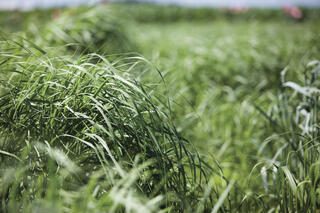Switchgrass harvest date affects xylose utilization and ethanol yield

Harvesting switchgrass prior to senescence may be an attractive option for farmers but results in poor xylose utilization.
The Science
Unlike harvest of corn stover, which is linked to grain harvest, timing of harvest for energy grasses such as switchgrass is relatively flexible. In this study, GLBRC scientists aimed to determine if switchgrass harvest could be timed to maximize beneficial impacts on fermentation while avoiding production of harmful degradation compounds.
The Impact
Establishing the best time of year to harvest switchgrass should not only take into account the competing interests of biomass yield and nutrient resorption, but also ethanol yield due to its influence on biorefinery economics. In this study, GLBRC scientists evaluated six harvest dates (three before and three after senescence) and determined that prior to senescence, ethanol yields were low due to poor xylose utilization. Their results suggested that harvest should be delayed until plants have begun to enter dormancy, but may not need to be after a killing frost.
Summary
In order to determine if switchgrass harvest date could be timed to result in the most beneficial impacts on fermentation, GLBRC scientists harvested switchgrass on six dates from peak biomass (late August) to killing frost (early November); three dates were prior to senescence and three were after. Results indicated that a rapid change occurred in switchgrass during the two-week period between the last harvest in September and the first harvest in October. Xylose was poorly consumed by Saccharomyces cerevisiae 424A in the three pre-senescence dates, leading to low ethanol yields, but in the three post-senescence dates, xylose was almost fully consumed, resulting in correspondingly higher ethanol yields. The source of inhibition of xylose utilization for the early harvest dates awaits further research. Overall, this work shows the benefit of delaying switchgrass harvest until the onset of dormancy, but with no apparent need to wait for a killing frost.
Contacts (BER PM)
N. Kent Peters
Program Manager, Office of Biological and Environmental Research
kent.peters@science.doe.gov , 301-903-5549
(PI Contact)
Rebecca G. Ong
Michigan Technological Universit
rgong1@mtu.edu , 906-487-2662
Funding
This material is based upon work supported by the U.S. Department of Energy, Office of Science, Office of Biological and Environmental Research under Award Number DE-SC0018409, and work funded by the DOE Great Lakes Bioenergy Research Center (DOE BER Office of Science DE-FC02-07ER64494).
Publications
Ong, R. G., et al. “Pre-senescence harvest of switchgrass inhibits xylose utilization by engineered yeast.” Frontiers in Energy Research 6, 52 (2018), DOI:10.3389/fenrg.2018.00052.
Related Links
https://www.frontiersin.org/articles/10.3389/fenrg.2018.00052/full